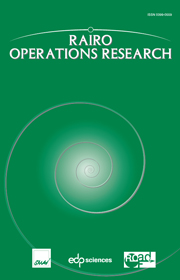No CrossRef data available.
Article contents
An SMDP model for a multiclass multi-server queueing controlproblem considering conversion times
Published online by Cambridge University Press: 11 July 2014
Abstract
We address a queueing control problem considering service times and conversion timesfollowing normal distributions. We formulate the multi-server queueing control problem byconstructing a semi-Markov decision process (SMDP) model. The mechanism of statetransitions is developed through mathematical derivation of the transition probabilitiesand transition times. We also study the property of the queueing control system and showthat optimizing the objective function of the addressed queueing control problem isequivalent to maximizing the time-average reward.
- Type
- Research Article
- Information
- Copyright
- © EDP Sciences, ROADEF, SMAI 2014


